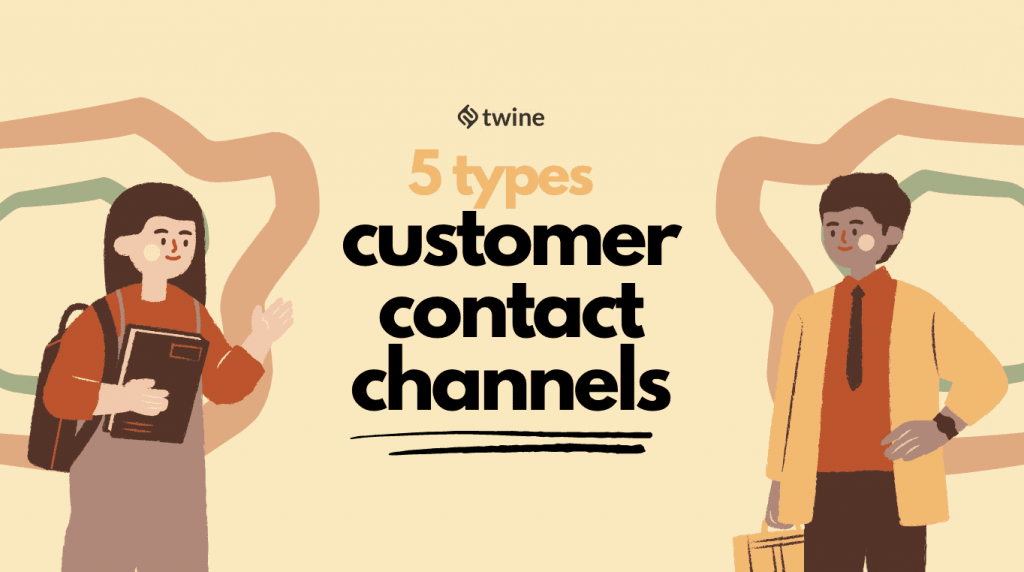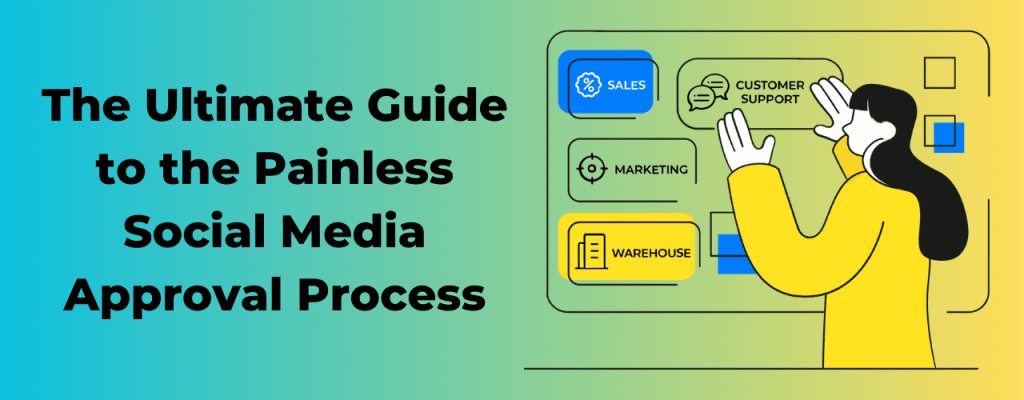
For more Social Media Tools, check out the Business Toolkit…
Are you looking for ways to improve customer communication? As a business owner, you know that customer contact channels are key to providing excellent customer service.
But what are the different customer contact channels? Which is best for your business?
In this blog post, we’ll discuss the five most popular channels used by businesses today. Then, we’ll provide an overview of each medium, and help you decide which is the best fit for your company.
Ready? Let’s dive in.
Need to hire a Social Media Manager to communicate with your customers? You should have said!
1. Social Media
Social media is a valuable communication tool businesses can use to connect with customers and promote relationships. If used effectively, social media can help companies to create rapport with consumers, resolve client issues, and generate leads.
Recently, social media platforms such as Facebook, Twitter, and Instagram have offered organizations a direct way to interact with potential and existing customers. As a result, various companies have started using the platforms as customer contact channels.
However, social media isn’t suitable for every business for the following reasons:
- Brands that sell high-end or bespoke products are unlikely to find the medium an effective contact channel. This is because potential clients will most likely want to speak to a human before making a purchase.
- Similarly, companies dealing with sensitive customer information are unlikely to find the platform an effective channel since it’s tough to keep data private on social media.
Below are several things to keep in mind when employing social media as a customer contact channel:
- Social media is a public platform – Anything you post will be viewable by anyone who visits your page. As such, it’s vital to be mindful of your language and the information you share.
- Not everyone uses social media – Indeed, the platform offers a direct way to reach consumers. However, it’s crucial to remember that not everyone has a social media account. As such, it’s still essential to have other contact channels as well.
Its advantages include reaching many people quickly and easily, thus allowing you to monitor customer sentiment in real time. On the other hand, some disadvantages include the risk of negative publicity if the company isn’t able to handle issues well. It also requires continuous monitoring to respond quickly to customer queries.
Given these points, social media can be an excellent way to connect with consumers. However, it’s crucial to implement it wisely with other customer contact channels.
2. Email
Another contact channel is email. This medium has become one of the most popular methods of communication for individuals and businesses. A study shows that in 2020 there were roughly 4 billion email users globally.
It’s fast, convenient, and relatively straightforward to use. Companies can quickly send clients updates, special offers, or other vital information. They can also use it to field customer questions or concerns. It is therefore essential to realize email fits businesses that have a large customer base and that need to communicate with clients regularly.
However, not all companies are fit to adopt email as a customer contact channel. Here are some reasons why:
- Organizations that rely on customer service representatives to deal with inquiries may find that email isn’t an ideal way to do so. This is because employees need to converse with clients to assist them best.
- Email doesn’t sit well with back-and-forth conversations. This is especially true if a client isn’t checking their email regularly.
- Some consumers prefer other communication methods, such as phone calls or live chat.
Despite these, email has advantages over other contact channels, such as phone or face-to-face communication. The medium is less expensive, allowing businesses to reach a larger audience. It also lets companies keep a record of their client communications. Then again, some of its drawbacks include:
- Email can be challenging to personalize.
- It can be easy for customers to ignore or delete email messages.
- Spam, malware, and phishing are all leading concerns for organizations using email as a contact channel.
- Spam filters can sometimes block legitimate email messages from reaching clients.
For these reasons, companies must weigh the advantages and disadvantages of using email as a customer contact channel before deciding if it’s right for them.
3. Live Chat
Meanwhile, live chat is a customer contact channel that allows businesses to communicate with customers in real time. A report shows that the global live chat market was worth $755.23 million in 2020.
The research also forecasts the sector to reach $1.7 billion by the year 2030. That’s to say, the platform is a popular choice for companies that want to provide customer support or sales assistance, as it can help resolve issues quickly and efficiently.
Is it for everyone?
Live chat is suitable for companies of all sizes, but it’s beneficial to small businesses as it can help create a personal connection with customers. Teams can also adopt the channel to upsell and cross-sell services and products.
Some of the main advantages of using live chat as a customer contact channel include the following:
- The platform can manage multiple client queries at the same time. This is because numerous customer support agents are typically available to chat with clients.
- Moreover, live chat is a speedy way to resolve customer issues. Clients don’t have to wait on the phone for an agent to be available.
- In addition, live chat provides a personal touch. Clients feel like they’re receiving one-on-one attention from a company representative.
Likewise, there are some drawbacks to implementing live chat, which include:
- The system can be pricey to set up and maintain.
- Businesses must have customer service agents available to handle inquiries during all operating hours.
- Additionally, support agents may find it challenging to resolve complex concerns. The staff may need to escalate the issue to a superior if they can’t fix it.
Overall, live chat is a valuable customer contact channel. However, companies must carefully consider its advantages and disadvantages before employing it.
4. Messaging App
These days, another prominent contact channel is the messaging app. Some popular apps include WhatsApp, Facebook Messenger, and WeChat, each with unique features and user interface. Businesses can use this platform to deliver customer support, send marketing messages, and build customer relationships.
This customer contact channel is suitable for companies with a large client base, such as ecommerce businesses. It’s likewise an excellent choice for organizations that intend to build a deeper relationship with their customers.
Is it for everyone?
Organizations that deal with confidential information or require a high degree of personalization may not fit this contact channel. In addition, this platform may be disruptive if not appropriately adopted. It may not also be the best choice for businesses that need to maintain a significant degree of customer engagement.
Still, messaging apps offer various advantages, which include:
- Businesses can use the app to automate customer support and marketing messages.
- The platform is less expensive than traditional channels like phone calls or emails, offering a more immediate way to reach customers.
- Messaging apps can reach a wider audience with less effort than other channels.
However, there are also some disadvantages to implementing the channel, such as:
- Customers may need to download an additional app to use the messaging function, which could create friction.
- There is usually a limit on the number of characters you can use in messages, making it challenging to convey complex details.
- Spam messages are a common problem with this platform, leading to customer complaints.
Ultimately, messaging apps offer businesses a unique avenue to connect with their clients. So if you’re looking for a brand-new way to get in touch with customers, messaging apps and other customer service tools are worth considering.
5. Phone
Many customer contact channels are available, but phone support remains one of the most popular and effective. This platform involves a company representative communicating with a client by phone. Customer support, sales, and marketing are all common uses for phone support.
The channel is suitable for businesses of all sizes, especially those with a large customer base and older demographics. For example, Baby Boomers and seniors are more likely to use this support than digital-native Millennials.
Is it for everyone?
Not every company should be implementing this contact channel. First and foremost, it’s crucial to have the workforce sustain phone support. This means having a team of customer service representatives available during business hours to take calls.
In addition, this channel can be costly, as it requires a dedicated phone line, sometimes toll-free numbers, and possibly an e-learning system for continuous training like iSpring Learn LMS.
Despite these, there are advantages to adopting this channel which include:
- Phone support allows organizations to have two-way communication with their customers.
- This contact channel is a personal form of communication that can build trust and rapport between the company and its clients.
- It’s suitable for addressing complex issues that are impossible to resolve through other mediums such as email or social media.
On the other hand, some of the constraints include:
- Phone support can be challenging to scale up if the operation receives more customer calls than it can manage.
- There’s always the risk of something going wrong during a call, such as dropped calls or poor sound quality.
- Clients may have to wait on hold for a long time before they can speak to a customer service agent.
All in all, phone support is an excellent way to provide customer service. However, ensuring that it’s the right channel for your business is crucial. You may consider other options if you don’t have the headcount to support it or if your clients are primarily millennials.
Wrapping up
The five customer contact channels outlined above are the most popular and effective ways to communicate with clients today. Live chat or messaging apps may be your best option if you want a more personal connection. However, if you need to reach many people quickly, social media and email are your best bets.
Finally, phone support can be very effective, but you should use it with other platforms. Whichever channel you implement, ensure you offer excellent customer service through each one.
Ready to hire? Our marketplace of over 410,000 diverse freelancers has the skills and expertise needed to skyrocket your business. From marketers to designers, copywriters to SEO experts – browse the talented bunch here!








